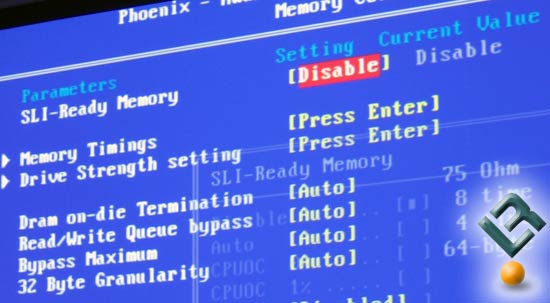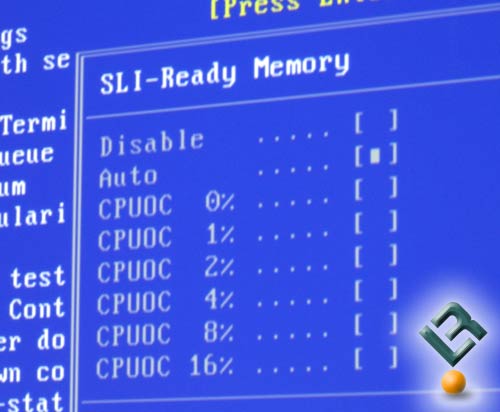DDR2 Memory: Enhanced Performance Profiles (EPP)
The SLI Memory BIOS
Since the NVIDIA AMD AM2 platform is not out yet and under NDA we are limited to showing you a couple of BIOS shots that we took of a reference NVIDIA nForce 590 SLI platform running a future AMD processor and Corsair’s XMS2 PC2-8500 memory modules with EPP support.

The first this you see in the ‘Memory Configuration’ is a setting for SLI-Ready Memory. It is here that users can either enable or disable the EPP functionality. If you enable SLI-Ready Memory then a menu will pop up like the one below.

Here we see the SLI-Ready Memory selection menu that is found when the setting is enabled. The menu has changed a bit over the past couple days and ‘Auto’ is now ‘MAX OC’. When MAX OC is selected the motherboard will overclock to the highest stable settings. When we used ‘MAX OC’ our mulitiplier on the AMD AM2 processor was lowered and the memory divider changed resulting in the memory trying to post at 1062MHz. The setting ‘CPU OC 0%’ is when you don’t want to overclock the processor, but want all the EPP settings enabled and to push the to peak performance levels. All of the other settings mean you will overclock the CPU and memory by a certain percentage all they way up to 16%.
Final Thoughts:
Since we are talking about technology on a platform that has yet to be released I find it hard to give my full thoughts on EPP, but it is interesting to say the least. Many reviewers in the industry see SLI-Memory with EPP as a way to “hand-hold” consumers, but I don’t really see it like that as you can disable the feature if you don’t want it. Right now I think NVIDIA and the memory companies are headed in the right direction. They are taking unused lines of space in the SPD and putting them to good use. Consumers are wanting more control over their memory timings and EPP makes sure enthusiasts and consumers have all the information they need right there on the module.
What are the limitations of EPP? The answer to that is simple, voltages. Since overclocking often requires that voltages be increased overclockers will find the BIOS overclocking features to lack the voltage required to many overclocks. For example if we wanted to overclock our system to ‘CPUOC 16%” it would not boot, but if we manually set the system and increased the voltages we could get 16% with no problem. I have a feeling that many die hard enthusiasts are going to use nTune or Everest to read the EPP, record the optimal memory timings, and then manually set everything in the BIOS.
Motherboard companies need to hae their BIOS updated in order to dectect EPP memory. We can tell you first hand that some upcoming boards currently do not support EPP memory, but hopfully future BIOS updates will fix the issue. Right now EPP is still taking off as you can tell, but in future months we expect the market to fully ready to support these modules. NVIDIA is also coming out with an updated platform for Intel processors and it too will feature EPP memory. So Intel fans need not feel left out.
Hope you enjoy or peak into Enhanced Performance Profiles and if you have any questions feel free to ask them in the forums and we will do our best to answer them for you!

Comments are closed.